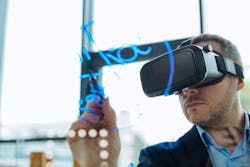The Universal Digital Ink Revolution: Cross-Industry Collaboration Around AI, AR, and VR
New developments over the past decade in digital ink technology have helped change the landscape for the stationery industry—pens, papers, and inks—and just about every type of device, stylus, and screen you can think of within the technology marketplace. Pens, devices, and displays embedded with new digital ink technology tools dramatically expand note-taking, signature and drawing applications, and enable new creative experiences.
I talked with the Digital Stationery Consortium’s Work Group Chair, Markus Weber, Ph.D., about how universal digital ink technology is opening up new business opportunities in the emerging digital stationery market. Weber is the Product Manager for WILL (Wacom Ink Layer Language) and Digital Ink at Wacom Europe GmbH. The consortium recently published a newly commissioned white paper titled “New Business Opportunities Fueled by the Emerging Digital Stationery Market,” which is available free via download from its website.
How has handwriting recognition and artificial intelligence evolved into digital ink technology?
Over the past decade, new developments in digital ink technology have helped change the landscape to bring stationery and technology marketplaces together into the emerging digital stationery market. These developments have allowed stationery brands to extend their product lines way beyond the conventional analog world. They’re arming traditional writing instruments, such as fountain pens from Montblanc, with digital capabilities, and mobile devices like Wacom's digital pen technology-based “S Pen” for the Samsung Galaxy Note8 with the ability to capture handwriting and drawing in live message texts.
1. Future digital stationery applications for AI, AR, and VR could take advantage of digital-ink-enabled painting and drawing with a stylus pen on the tablet. (Courtesy of Wacom)
However, without a common standard, digital ink technology has evolved and advanced across entire industries, resulting in many different standards and file formats (Fig. 1). This either means that the digital ink technology is incompatible across platforms or slows down collaboration between objects, devices, and people that end users expect to be seamless.
What is being done to create a universal digital ink framework?
To solve this issue, E Ink, Montblanc, Fujitsu Computing Client Limited, Samsung, Wacom, and other leading companies with a passion for writing, drawing, and technology have joined forces as the Digital Stationery Consortium (DSC). Check out the video:
The DSC is an association of global industries and thought leaders with the shared mission to establish digital ink as a universal, open, and smart content format and a common framework for sharing and collaborating with ideas based on WILL digital ink.
Authored by industry analyst Dr. Jon Peddie of Jon Peddie Research, the DSC-commissioned white paper, available for free download on the DSC website, examines the cross-industry efforts to enable a universal digital ink framework using WILL to ensure that new digital stationery experiences all work universally across software, hardware, and applications regardless of the platform (Fig. 2).
2. Universal digital ink technology enables an endless number of digital stationery experiences.
What is WILL (Wacom Ink Layer Language)?
The universal digital ink technology language WILL literally turns every digital pen technology—stylus, smart pen, smartpad—into a data format can then be adapted, edited, or shared in any other hardware operating system or application. Using algorithms, WILL’s digital ink technology transforms pressure, speed, and orientation information into a visual representation of digital ink technology. WILL contains tools for manipulating, storing, and producing digital ink technology—all from raw pen sensor data.
The paper highlights how the DSC is working to advance WILL as a universal digital ink technology (Fig. 3) by tapping into the benefits of emerging technologies, such as artificial intelligence (AI), blockchain, augmented reality (AR), and virtual reality (VR).
3. WILL, the universal digital ink technology framework, enables multimodal input to capture emotion and personality. (Courtesy of Wacom)
WILL makes collaboration simple and seamless. As a universal inking engine and ink-layer framework, WILL connects hardware, software, and applications, making collaborations with ink between different entities easy. It allows users to exchange creations between any devices that use WILL. The technology enables the ink to remain editable, and it can be used in different WILL-compatible apps, software, and services.
Unique advances include:
- Ability to turn handwritten signatures into biometric electronic signatures to sign important documents or use dynamic signature verification to verify the person’s identity for an authentication process, such as approving a purchase order. Stored metadata, such as location or identification of the author, lets you easily track time and order of changes, identify who did the changes, add, erase, and insert hand-written comments in documents—in a way that has not previously been possible.
- High-performance writing and sketching tools are based on raster rending to provide greater flexibility regarding expressiveness, while the writing tools use vector rendering that’s optimized for writing. Natural and fast rendering of ink creates the most natural writing experience, with a direct response on screen. Visually aesthetic natural stroke dynamics further enhance the experience.
- Support for a variety of input technologies generates the best possible ink through the use of dedicated modules. Path and smoothing modules take into account the specific characteristics of input pen data. The Rasterizer module then provides advanced real-time stroke rendering. The Manipulation module supports editing functions that leverage the WILL stroke mathematical model. The Serialization module encodes and decodes stroke data.
The WILL SDK for ink, which is available to DSC members, offers the essential toolbox for developers to create basic apps for sketching, note-taking, collaboration, AR, and other applications aimed at intuitive creativity, digital learning, and education. It’s a toolkit that contains both the WILL data format and tools needed to manipulate, produce, and store digital ink in different rendering styles, such as the ink from a fountain pen (Fig. 4).
4. The universal digital ink framework offers natural ink capabilities that make digital-ink-enabled writing as easy and fast as with pen on paper.
What major trends do you see in digital ink technology in 2018?
New technology applications, as well as new approaches to traditional stationery products and applications, are allowing both stationery and technology providers to offer new ways to both differentiate themselves from the competition and work as a modern version of the stationery kit. Instead of paper, pens, and luxury inks, today we are seeing the emergence of the stationery kit’s digital counterpart—digital stationery. In the future, you may use your favorite fountain pen to handwrite notes, but also store those notes digitally in the cloud.
Analyst Dr. Jon Peddie of Jon Peddie Research, the white-paper author, highlights that the digital ink and stationery industries are on the cusp of a technological point-of-no-return: “With universal digital ink technology as the framework, the global opportunities for digital stationery market innovation are riper than ever. The world of pens, paper, and ink is spilling over into an ever-connected, digital stationery world, and developers, OEMs, and other innovators have the chance to drive rapid growth across an unlimited number of markets.”
Over the last several years, artificial intelligence has played a large role in the growth and diversification of digital ink’s ability to capture every stroke, emotion, and rotation behind handwriting a message, taking notes, or expressing oneself creatively. Doodling, drawing, and writing is now something you can do nearly everywhere digital ink is embedded, such as in your school notebook, on your laptop at work, or on your smartphone tablet while on the go.
In the future, any screen or small touch surface may extend to your refrigerator at home or a screen in a car. We've seen a lot of development in the software and tools that allow people to maximize the potential of artificial intelligence, such as in signature verification and note-taking.
The DSC vision is that as digital ink advances to become smarter and more intelligent, a universal framework is needed to ensure that every mark of the hand and stroke of the pen is captured in a sharable, editable smart data format.
Currently, the DSC’s Work Groups are collaborating with experts from a wide range of industries to completely transform how consumers use digital-ink-enabled products and services. The DSC Developer Engagement Work Group is connecting with developers to build momentum for its adoption; the DSC Customer Use Cases Work Group is examining tangible return on investment for cases that bridge analog and digital industries; and the DSC Technology Work Group is working to define the requirements for digital ink within emerging technologies, such as AI, AR, and VR; blockchain; and Internet of Things.
5. Common symbols and diagrams hand-drawn with digital ink and aided by AI could enable digital-stationery applications that can interpret the drawing and digitally render the correct diagram.
Work is currently underway within the DSC Work Groups to explore how AI can improve digital-ink-based note-taking and real-time collaboration, as well as how VR can enhance digital-ink-based creativity in 3D environments. And, to build momentum for digital ink adoption, the DSC is building a community of developers that can be accessed by DSC members to support go-to-market efforts for new products or to validate new concepts (Fig. 5).
For example, Montblanc, Wacom, and other members of the DSC Use Case Work Group, including the German Research Center for Artificial Intelligence (DFKI), are looking at how AI can further enhance smart services, like note-taking, which require semantic text or diagrams to work. Semantic recognition of dates, contacts, topics, diagrams, or keywords could trigger actions such as adding meeting dates with the correct contact to a calendar or turning a hand-drawn circuit design into a digital diagram. Now imagine, you draw a pendulum and all of a sudden it comes to life and starts to swing, or you draw a circuit and immediately simulate its behavior.
6. Writing and learning in a VR world will be a digital stationery experience that’s enabled by digital ink technology innovation.
Analyst Jon Peddie highlights that other use cases could include enhancing WILL for VR ideation—communicating ideas directly in 3D though AR and VR, enabling the entire design process to be created within single VR environment (Fig. 6).
How can companies get involved in the DSC?
We invite others to join the DSC to shape how digital ink innovations become part of a larger digital stationery market. All companies interested in the digital ink ecosystem are encouraged to become DSC members. DSC membership levels, Contributors and Promoters, are open to companies across any business vertical.
Digital-stationery-focused technology startups and academic entities are invited to apply for a free, one-year Promoter member application. Once approved, the Promoter membership fee is waived for the first year, and members can participate in DSC’s technical and educational efforts via the consortium’s Work Groups. Members receive access to WILL technology as well as the opportunity to become involved in various membership initiatives, Work Groups, and member-only meetings.
If companies are interested in becoming a member, would like to join our mailing list, or would like to learn more about the DSC, go here.
Reference:
Digital Stationery Consortium Commissioned White Paper, New Business Opportunities Fueled by the Emerging Digital Stationery Market, by Dr. Jon Peddie of Jon Peddie Research, November 16, 2017.








